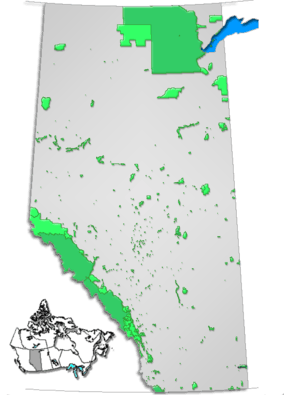Jasper National Park
| Jasper National Park | |
|---|---|
|
IUCN category II (national park) | |
|
| |
 Jasper Park Location | |
| Location | Alberta, Canada |
| Nearest city | Jasper |
| Coordinates | 52°48′N 117°54′W / 52.8°N 117.9°WCoordinates: 52°48′N 117°54′W / 52.8°N 117.9°W |
| Area | 10,878 km2 (4,200 sq mi) |
| Established | 1907 |
| Visitors | 1,991,482[1] (in 2012) |
| Governing body | Parks Canada |
| World Heritage Site | 304 |
Jasper National Park is the largest national park in the Canadian Rockies, spanning 10,878 km2 (4,200 sq mi). It is located in the province of Alberta, north of Banff National Park and west of the City of Edmonton. The park includes the glaciers of the Columbia Icefield, hot springs, lakes, waterfalls and mountains. Wildlife in the park includes elk, caribou, moose, mule deer, white-tailed deer, mountain goats, bighorn sheep, grizzly bears, black bears, coyotes, beavers, Rocky Mountain pikas, hoary marmots, grey wolves, mountain lions, and wolverines.
History
Jasper was named after Jasper Hawes, who operated a trading post in the region for the North West Company. Before this it was referred to as Fitzhugh. The park was established on September 14, 1907 as Jasper Forest Park, and was granted national park status in 1930, with the passing of the National Parks Act.[2]
In 2012, Jasper National Park had 1,991,482 visitors.[1]
World Heritage Site
This park was declared a UNESCO World Heritage Site in 1984, together with the other national and provincial parks that form the Canadian Rocky Mountain Parks, for the mountain landscapes containing mountain peaks, glaciers, lakes, waterfalls, canyons, and limestone caves as well as fossils found here.
Geography
byRyanSchroeder.jpg)
Major river systems originating in the park include the Athabasca and Smoky rivers (part of the Arctic Ocean basin).
Attractions

Some of the park's scenic attractions include Mount Edith Cavell, Pyramid Lake with Pyramid Mountain, Maligne Lake, Medicine Lake, and the Tonquin Valley. Other attractions are the Marmot Basin ski area; the Snocoach tours of the Athabasca Glacier, an outlet glacier of the Columbia Icefield; Athabasca Falls; the Jasper Skytram, and numerous other outdoor related recreational activities (such as hiking, fishing, wildlife viewing, rafting, kayaking and camping). The Miette Hot Springs are located close to the northeast entrance. The Miette Hot Springs are created by an extremely hot spring cooled by the mountain to temperatures suitable for humans.
The Icefields Parkway is a highway 230 km (140 mi) in length from Lake Louise, Alberta in Banff National Park, to Jasper, Alberta. The highway parallels the continental divide, providing motor and cycle access to the mountains. The Athabasca and Sunwapta Falls are both accessible by the road.
In popular culture

Jasper National Park is featured in the 2010 3D animated comedy-drama film Alpha and Omega as the location the two wolf protagonists are taken from and struggle to return to.[3][4][5][6]
See also
- Jasper Park Information Centre National Historic Site
- St. Mary & St. George Anglican Church, Jasper, Alberta. Provincial Historic Site
- Ecology of the Rocky Mountains
- Dark-sky preserve
- List of National Parks of Canada
- List of parks in Alberta
- List of trails in Alberta
- List of mountains in Alberta
- List of waterfalls of Alberta
References
- ↑ 1.0 1.1 "Jasper National Park of Canada Annual Report 2013" (PDF). Parks Canada. 2013. Retrieved May 29, 2014.
- ↑ Parks Canada (January 2004). "Jasper National Park of Canada Visitor Information". Retrieved 2007-02-07.
- ↑ Loup, Mat (September 10, 2010). "US pet day celebrations launch animated ‘Alpha and Omega’ movie.". Media centre. Retrieved March 3, 2012.
- ↑ "Alpha and Omega promo video". Tourism Jasper's blog. Tourism Jasper. 2010. Retrieved March 3, 2012.
- ↑ Mah, Bill (September 28, 2010). "Jasper hopes for Hollywood bounce". Edmonton Journal. Retrieved March 3, 2012.
- ↑ White, Carrie (December 16, 2010). "Tourism Jasper Has A Busy First Year". The Fitzhugh. Retrieved March 3, 2012.
External links
| Wikimedia Commons has media related to: |
| Wikivoyage has a travel guide for Jasper National Park. |
- Parks Canada. Jasper National Park
- Tourism Jasper. Tourism Jasper
| ||||||||||||||||||||||||||
| ||||||||||||||||||||||||||
| ||||||||||||||||||||||||||||||||||||||||||||||||||||||||
| ||||||||||||||||||||||||||

